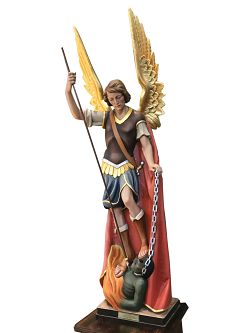The Archangels: 'Ministering Spirits Sent Forth to Serve'

With the approach of the Feast of Saints Michael, Gabriel and Raphael on Sept. 29, I’ve been giving some thought to angels.
As with much of our faith, popular perception and Church teaching differ on angels. Cherubim in the Bible, for example, aren’t the fat little winged babies often portrayed in modern media; rather, they have two pairs of wings and four faces: one of a lion, one of an ox, one of an eagle and one of a human. They also have eyes all over their bodies. In addition to serving as God’s attendants, they also are the creatures stationed in Eden “to guard the way to the tree of life,” as Genesis tells us.
The fifth-century theologian Pseudo-Dionysius, in his book De Coelesti Hierarchia (On the Celestial Hierarchy), grouped the angels into three orders, each with three tiers. Seraphim and cherubim belong to the highest order, while archangels belong to the lowest order.
Of the archangels, the Catholic Scriptures give us the names of three: Michael, Gabriel and Raphael. Here’s what St. John Paul II had to say about these three in his 1986 “Catechesis on the Angels:”
The name of Michael the Archangel “is a synthesis that expresses the essential attitude of the good spirits. ‘Mica-EL’ in fact means: ‘Who is like God?’ In this name, therefore, we find expressed the salvific choice thanks to which the angels ‘see the face of the Father’ who is in Heaven,” the pope said.
Gabriel is “a figure bound especially to the mystery of the Incarnation of the Son of God. His name means ‘my power is God’ or ‘power of God,’ as if to say that the culmination of creation, the Incarnation is the supreme sign of the omnipotent Father,” the pope said.
The name Raphael (Rafa-EL) “means: ‘God heals.’ He is made known to us by the story of Tobias in the Old Testament, which is so significant for what it says about entrusting to the angels the little children of God, who are always in need of custody, care, and protection.”
John Paul II goes on to say that, “If we reflect well, we see that each one of these figures, Mica-EL, Gabri-EL, and Rafa-EL reflects in a particular way the truth contained in the question posed by the author of the Letter to the Hebrews: ‘Are they not all ministering spirits sent forth to serve, for the sake of those who are to possess salvation?’”
Looking to the Bible, we see Gabriel mentioned four times by name: twice in the Old Testament and twice in the New Testament. Each time he bears a message, so perhaps it’s not surprising that he’s the patron saint of communicators.
St. Michael the Archangel is named five times in the Bible: three times in the Old Testament and twice in the New Testament. In the Book of Daniel, Michael is seen as an advocate of the Jewish people; in the Book of Revelation he leads God’s armies against Satan. He is the patron saint of police officers, paramedics and the military.
Raphael is found only in the Old Testament. In the Book of Tobit he guides Tobias to Ecbatana, helps the young man exorcise a demon from Sarah, and heals Tobit of his blindness. Traditional names Raphael as the angel who stirred the waters of the pool of Bethesda. He is the patron saint of the blind and of nurses and physicians.
In Islamic tradition, Raphael is called Israfil; Gabriel and Michael also appear in the Quran.
Our own catechism teaches that human life, from beginning to death, is surrounded by the watchful care and intercession of angels. Therefore, on Michaelmas, I will pray to Michael to protect our world against evil, to Raphael for healing of the sick and wounded, and to Gabriel to aid us Christians in carrying out our work as evangelizers.
Saints Michael, Gabriel and Raphael, intercede for us.
Marie Mischel is editor of the Intermountain Catholic. Reach her at Marie@icatholic.org.
© Copyright 2024 The Diocese of Salt Lake City. All rights reserved.


Stay Connected With Us